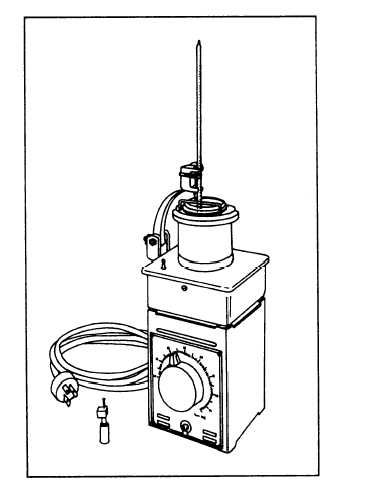that has a thermometer running through the stopper, as
shown. The flask and contents are heated. As the
temperature rises, distillate is given off in the form of
vapor. A condenser returns the vapor to liquid form, and
the liquid (the distillate) is caught in a volumetric beaker.
The test indicates what can be expected in the
application and use of the materials. The distillation
temperature ranges from 374°F to 680°F for RC asphalt
cutbacks, from 437°F to 680°F for MC, and only at
680°F for SC. Road tars are distilled at temperatures that
range from 338°F to 572°F, and tar-rubber blends from
170°F to 355°F. The amount distilled is expressed as a
percentage of the total. The residue is the difference
between the distillate and the total. The percentages of
distillation may be as little as 1 percent for tar-rubber
distilled at 170°C (338°F) to as much as 59 percent when
RC and MC cutbacks and tars are heated to the higher
temperatures.
Record the volume of bitumen remaining in the
flask. If the residue is solid enough to be tested, it is
subjected to the penetration test described later in this
chapter. If it is solid enough for this test, the residue must
be asphaltic cement, and the original material was either
RC or MC. If it is not solid enough for penetration
testing, the original material was SC.
Finally, you can determine the grade by calculating
the percentage of bitumen and comparing it with the
ranges previously given.
Flash Point Tests
The flash point of a bitumen that contains a volatile
distillate is the temperature at which it begins to give off
ignitable vapor. The principal purpose of flash-point
testing is to determine maximum safe mixing and
applying temperatures; however, these tests are an aid
to identification as well. Referring again to table 13-6,
you see that RC and MC have flash points below 175°F.
MC-30 and SC-70 have flash points around 150°F, but
the other grades of SC have flash points above 175°F.
Testing for a flash point below 175°F is done with
the tag open-cup equipment shown in figure 13-31.
When testing for flash points above 175°F, use the
Cleveland open-cup equipment shown in figure 13-32.
When using either of these testers, you need to follow
the procedures described in NAVFAC MO-330. While
there are important procedural differences, flash-point
testing using either equipment is similar in that you use
the equipment to heat the test sample at a prescribed rate
of temperature increase. Then, when the temperature
reading on the thermometer nears the estimated flash
Figure 13-31.—Tag open-cup flash point tester.
point (table 13-6), you use an alcohol torch to begin
passing a flame across the surface of the sample. The
flash point is reached when the test flame produces a
distinct flicker or flash on the surface of the sample. At
this point you read the thermometer and record the
temperature.
Penetration Test
Figure 13-33 shows an asphalt penetrometer that is
used to determine the grade of asphalt cement. In
performing the test, the needle is carefully brought to
contact with the surface of the sample, then released so
as to exert a pressure of 100 grams. The seconds after
the needle is released, the distance it penetrated the
sample is read, to the nearest 0.01 centimeter, on the
penetrometer dial. The reported penetration is the
average of at least three tests on the same material whose
values do not differ more than four points between
maximum and minimum. Detailed procedures can be
found in NAVFAC MO-330.
13-44


